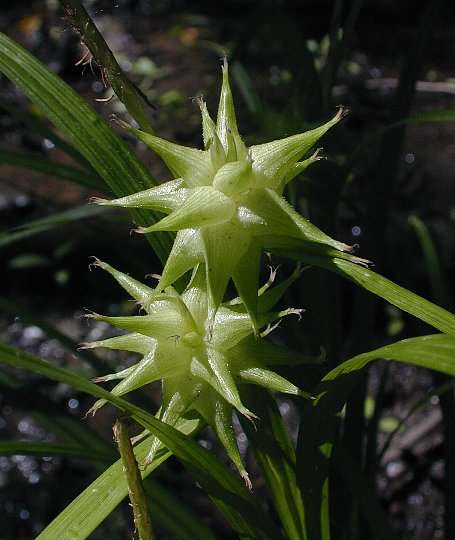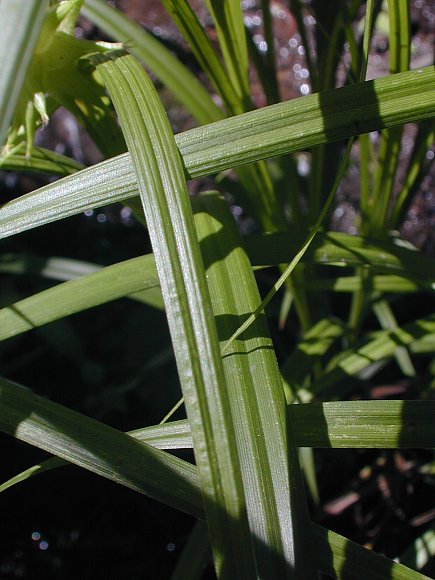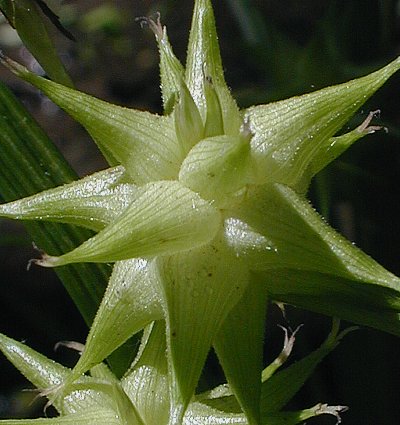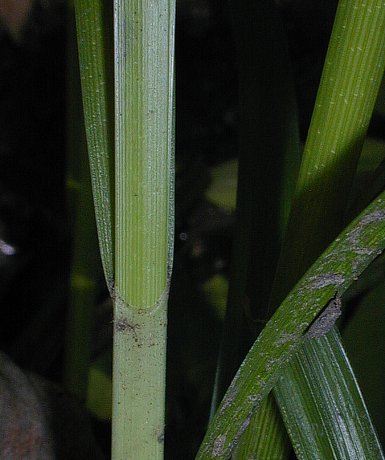Description: Fertile shoots of this perennial sedge are about 2–2½' tall; sometimes infertile shoots occur that are shorter. This sedge may consist of a loose tuft of leaves and culms (stems), or it may develop as a solitary leafy culm. Each culm is light green, 3-angled, glabrous, and unbranched; there are several alternate leaves along its length. The leaf blades are up to 14" long and 10 mm. across; they are ascending to widely spreading. The leaf blades are medium to dark green, glabrous, and often longitudinally furrowed. The outer 2 sides of the leaf sheaths are light green and glabrous, while their inner sides are pale white, membranous, and glabrous. The apex of each inner sheath is concave along its upper margin. Each culm terminates in an inflorescence consisting of 1-2 pistillate spikelets and a single staminate spikelet. Each pistillate spikelet consists of a globoid cluster of perigynia that radiate in all directions; each pistillate spikelet spans about 1–1½" across and its appearance is spiky. Each perigynium is about 12-18 mm. long and 4-8 mm. across; it is ellipsoid-lanceoloid in shape, tapering gradually to a long beak at its apex, while its bottom is wedge-shaped. Each perigynium is either glabrous (var. grayi) or finely pubescent (var. hispidula), and it has several longitudinal veins along its sides.

The pistillate scales are about one-half of the length of the perigynia; they are more or less ovate and sometimes awned. The pistillate spikelets have short stiff peduncles up to 1½" long. At the base of each peduncle, there is a leafy bract that resembles the leaf blades. The staminate spikelet is about 1.5–6 cm. (½–2½") in length; it is narrow and straight, soon becoming yellowish brown shortly after releasing its pollen. The staminate spikelet is located next to the uppermost pistillate spikelet or a little above it on a short peduncle. The blooming period occurs from late spring to mid-summer, lasting about 1-2 weeks for a colony of plants. The florets of the spikelets are cross-pollinated by the wind. Immature pistillate spikelets are light green, but they later become yellowish brown to dark brown. After disarticulation from their spikelets, the inflated perigynia have the capacity to float on water, by which means they are distributed to new areas. Mature achenes are 3.5-4.5 mm. long, 2.5-3.5 mm. across, obovoid, and bluntly 3-angled; there is one achene per perigynium. The root system is fibrous and rhizomatous.

Cultivation:
The preference is partial sun to medium shade, wet to moist
conditions, and soil containing loam, silt, or sand with decaying
organic matter. Temporary flooding is tolerated.
Range & Habitat:
The native Gray's Sedge is occasional to locally common in most areas
of Illinois; it may be less common in NW Illinois than elsewhere (see Distribution
Map). Habitats include wet to moist deciduous woodlands,
sandy and non-sandy swamps, low shaded areas along streams, and shaded
seeps. Occasionally, Gray's Sedge spreads to adjacent mesic areas of
woodlands, but this habitat is less typical for this sedge. It
is found in average to high quality natural areas.

Faunal Associations: This sedge is somewhat unusual in that it occurs in both wetlands and woodlands. Insects that feed on such sedges (Carex spp.) include caterpillars of the butterfly, Satyrodes appalachia (Appalachian Brown), leaf-mining larvae of the moths Elachista argentosa and Elachista madarella, larvae of the moth Amphipoea americana (American Ear Moth), larvae of Sphenophorus costicollis (Sedge Billbug), and the aphid Carolinaia caricis. The seeds and seedheads of sedges are fairly important sources of food for various birds. The seeds of sedges that occur in swampy woodlands are eaten by such birds as the Ruffed Grouse, Wild Turkey, Wood Duck, American Woodcock, and Swamp Sparrow. The Muskrat occasionally feeds on the rhizomes, culms, and young shoots of sedges, while the White-Tailed Deer and Black Bear feed on their foliage sparingly.

Photographic
Location:
Along a small stream in Busey Woods at Urbana, Illinois. Because the
photographed sedge has finely pubescent perigynia, it is Carex grayi hispidula,
rather than the typical variety.
Comments:
The pistillate spikelet of this attractive sedge resembles a medieval
mace. Because of this unusual characteristic, Gray's Sedge is fairly
easy to identify. It is closely related to a less common sedge, Carex
intumescens, which has a similar appearance. This latter
species has pistillate spikelets that are less globoid in shape
(because its
lowermost perigynia are less declined than those of Gray's
Sedge) and the bases of its perigynia are rounded, rather than
wedge-shaped. Like many other wetland sedges, the perigynia of Gray's
Sedge are inflated to facilitate the dispersal of their seeds by water.
More terrestrial sedges on dry land usually have flattened perigynia,
sometimes
with narrowly winged margins, to facilitate the dispersal of their
seeds by wind.